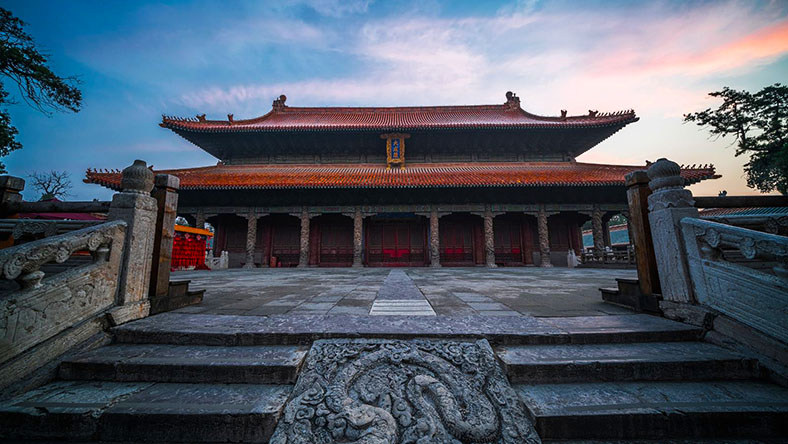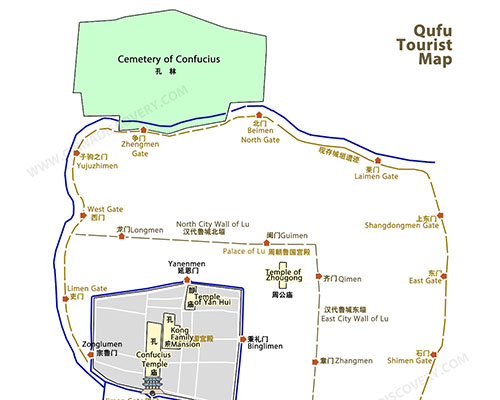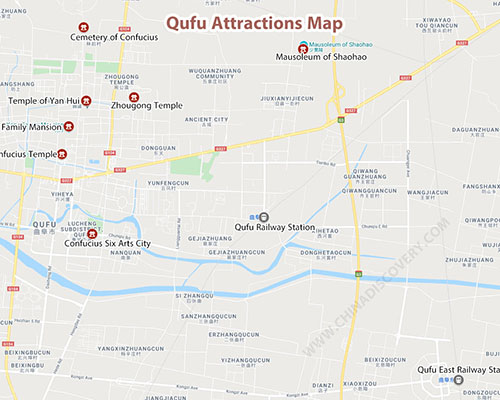History of Confucius Temple
Widely known as one of the most important and influential individuals in history, Confucius, the Chinese philosopher, educator, and politician of the Spring and Autumn period (770–476 BC), through his teaching and philosophy, has impacted people around the world greatly even till today. The Temple of Confucius is a temple to venerate him as a great sage and philosopher of Confucianism. The first Confucius temple was built two years after the death of Confucius in Qufu in the capital of State Lu, and his former house was consecrated as a temple by the Duke of Lu. In 205 BC, Emperor Liu Bang of the Han Dynasty offered sacrifices to Confucius temple in Qufu for the first time. He set an example for many emperors and high officials to follow. Later, a total of 12 different emperors visited Qufu to worship Confucius. About 100 others sent their deputies for 196 official visits. The original three-room house of Confucius was removed from the temple complex during a rebuilding undertaken in 611 AD. During the Song Dynasty, the temple was extended into a design with three sections and four courtyards, around which more than 400 rooms were arranged. Confucius Temple has endured not only fame but also destructions and restorations over centuries. Fire and vandalism destroyed the temple in 1214, during the Jin Dynasty. It was restored to its former extent by the year 1302 during the Yuan Dynasty. Shortly thereafter, in 1331, the temple was framed in an enclosure wall modeled on the Imperial Palace. After another devastation by fire in 1499, the temple was finally restored to its present scale. In 1724, yet another fire destroyed the main hall and the sculptures it contained. The subsequent restoration was completed in 1730. Many of the replacement sculptures were again destroyed in 1966. The temple of Confucius has experienced 15 major renovations, 31 large repairs, and countless small repairs.
Popular Qufu Tours: ✔ 3 Days Confucius Culture Exploration with Sidetrip to Mount Tai / 2 Days Mount Tai & Qufu Tour from Beijing by Bullet Train
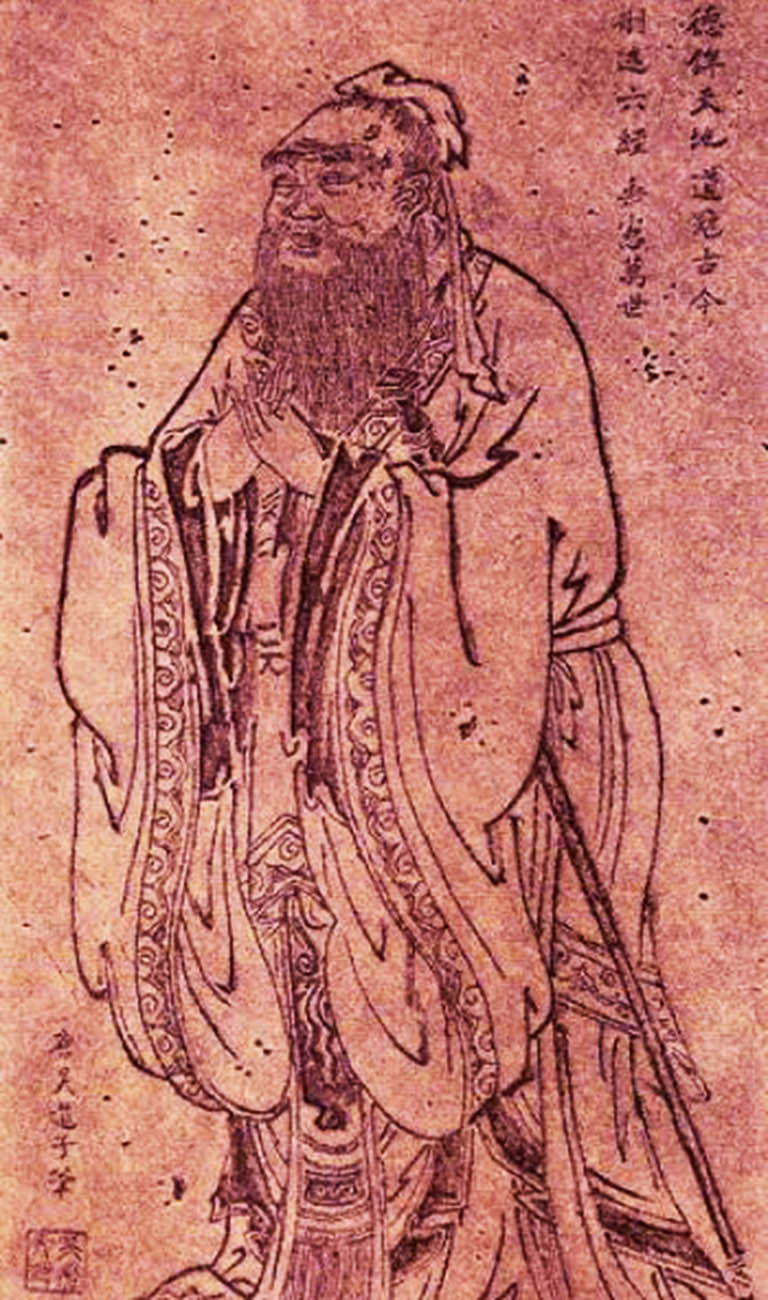 The teaching Confucius. Portrait by Wu Daozi, 685–758, Tang dynasty
The teaching Confucius. Portrait by Wu Daozi, 685–758, Tang dynasty
Where is the temple of Confucius
With the development of Confucianism, numerous Confucius Temples were built with the spreading of Confucianism throughout China. Besides the Confucius Temple in Qufu, other well-known temples include the Confucius Temple in Jianshui, the Confucius Temple in Xian (Forest of Steles), Fuzi Miao Temple in Nanjing, Confucian Temple in Tianjin, and Confucius Temple in Beijing.
As Confucianism spreads overseas, Confucian temples were also built in Vietnam, Korea, Japan, Malaysia, etc. In the 18th century, some were even built even in Europe and America. there are estimated to have been over 3,000 Confucian temples in existence in the world.
However, back to the root, the largest and greatest Confucius Temple is in Qufu, Shandong Province, the hometown of Confucius. It was built by Duke Ai, the ruler of State Lu, one year after Confucius’ death. The Temple expanded gradually in over 2000 years and became an ancestral temple belonging to the Kong lineage.
Temple of Confucius in Qufu, together with the Cemetery of Confucius (孔林; Kǒnglín) and the Kong Family Mansion (孔府; Kǒngfǔ), these 3 building complexes are called “San Kong”, meaning the three Confucian sites, all of which have been listed as a UNESCO World Heritage Site in 1994.
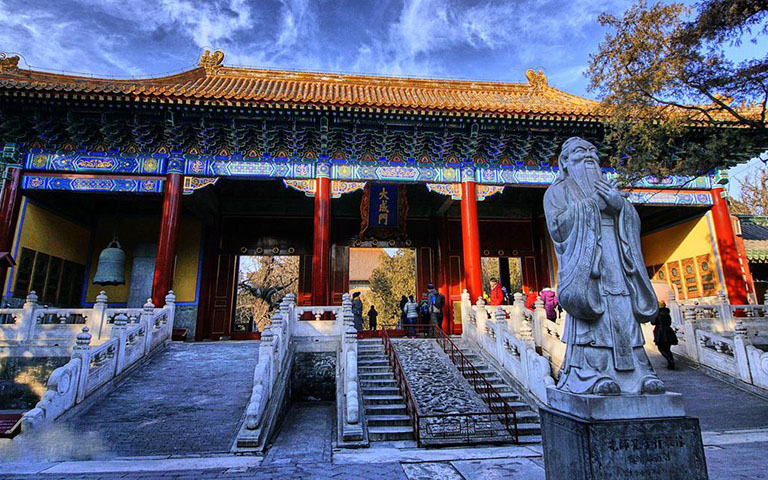 Confucius Temple in Beijing
Confucius Temple in Beijing
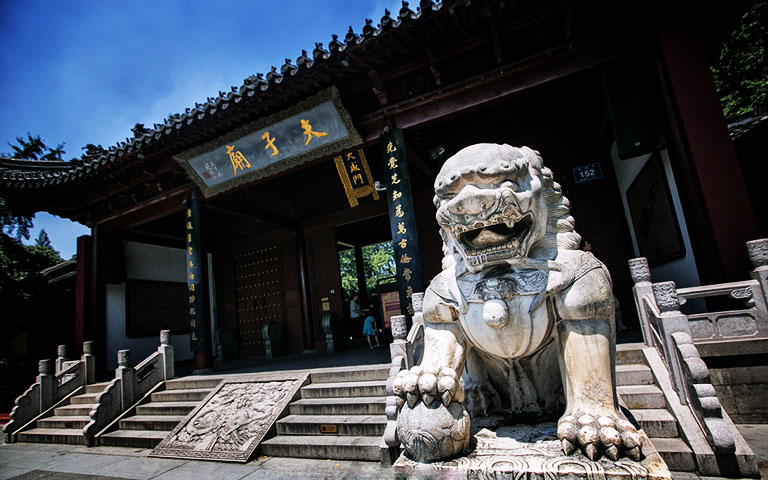 Confucius Temple (Fuzi Miao) in Nanjing
Confucius Temple (Fuzi Miao) in Nanjing
Temple of Confucius in Qufu 孔庙
•
•
As one of the largest historical building complexes in China (after the Forbidden City in Beijing and Summer Resort in Chengde), the Temple of Confucius in Qufu (Chinese: 孔庙; pinyin: Kǒng Miao) covers an area of 16,000 square meters (170,000 sq ft) with a total of 460 rooms. The temple was built on a central axis in a north-south direction with about 1.3 kilometers in length with 9 courtyards. The houses, rooms, and courtyards are very impressive with the traditional Chinese decorative elements of yellow glazed tiles, red-painted walls, and green trees. It was built in imitation of the imperial palace. It is one of the three largest ancient buildings in China. In 1994, it was listed as "world cultural heritage" by UNESCO. The buildings of Confucius Temple run through a central axis from north to south. The middle road starts from Jinsheng Yuzhen square (金声玉振坊) and passes through Lingxing gate (棂星门), Taihe Yuanqi square (太和元气坊), Shengshi gate (圣时门) and Bishui bridge (壁水桥) from south to north. After entering the Dazhong gate (大中门), it passes through the Kuiwen Pavilion (奎文阁), the Thirteen Stele Pavilion (十三碑亭), Dachengmen gate (大成门), Xintan Pavilion (杏坛), the Dacheng hall (大成殿), and Shenji Hall (圣迹殿), which is the main body of the Confucius Temple. The main buildings in the temple are as follows:
Kuiwen Pavilion 奎文阁
Kuiwen Pavilion, also known as the library of Confucius Temple, is a pavilion dedicated to the collection of books and paintings given by emperors of past dynasties. It has three cornices, four-story arches. It is a tall building only second to Dacheng hall.
Thirteen Stele Pavilion 十三碑亭
Located in the courtyard between Kuiwen Pavilion and Dachengmen, Thirteen Stele Pavilion is known for the steles. There are 8 in the south and 5 in the north, commonly known as the Imperial Stele Pavilion, built by the emperors of different dynasties to offer sacrifices to Confucius. There are more than 50 monuments in the Tang, Song, Jin, Yuan, Ming, and Qing Dynasties with different styles of calligraphy on them.
Xintan Pavilion 杏坛
Xing Tan Pavilion standing in the center of the courtyard in front of Dacheng Hall, also known as Apricot Platform, was built to commemorates Confucius teaching his students under an apricot tree.
Dacheng Hall 大成殿
The Dacheng Hall is the representative central site of the complex covering an area of 54 by 34 meters and serving as the principal place for offering sacrifices to the memory of Confucius, a place where Confucius lectured in his late years. Covering an area of more than 1800 square meters, it is the main place for worshipping Confucius in ancient times. There is a statue of Confucius in the middle of the hall with other statues of his students: Yanzi, Zengzi, Zisi, and Mencius.
Note: 1. There are English speaking guides in the tourist service hall and Confucius Temple Square.2. Usually, if you can come around 8:00 in the morning, actors in ancient costume will perform at the opening ceremony outside the South Gate of the Confucius Temple, and there will be a closing ceremony at 5:00 p.m. (5:30 in peak season).
Qufu International Confucius Cultural Festival
Each year in September, an international cultural Confucius festival will be held to commemorate his birthday. Qufu International Confucius Culture Festival was founded in September 1989. It is held in Qufu City, the hometown of Confucius before and after the birthday of Confucius every year on September 28. During the festival, performances of ancient worship, traditional dance, special rituals performances will be present to the visitors from overseas and at home.
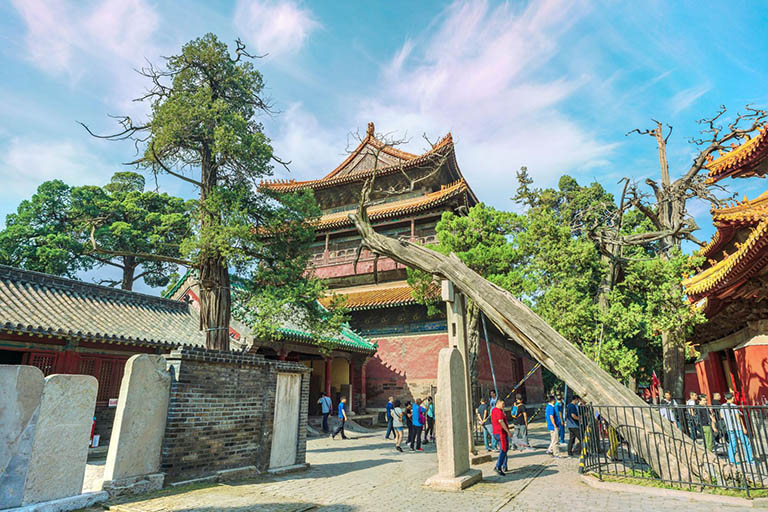 Kuiwen Pavilion 奎文阁
Kuiwen Pavilion 奎文阁
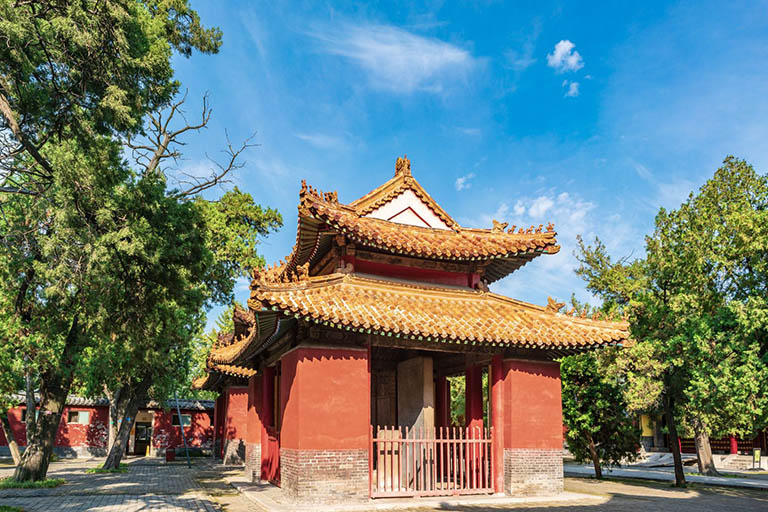 Thirteen Stele Pavilion 十三碑亭
Thirteen Stele Pavilion 十三碑亭
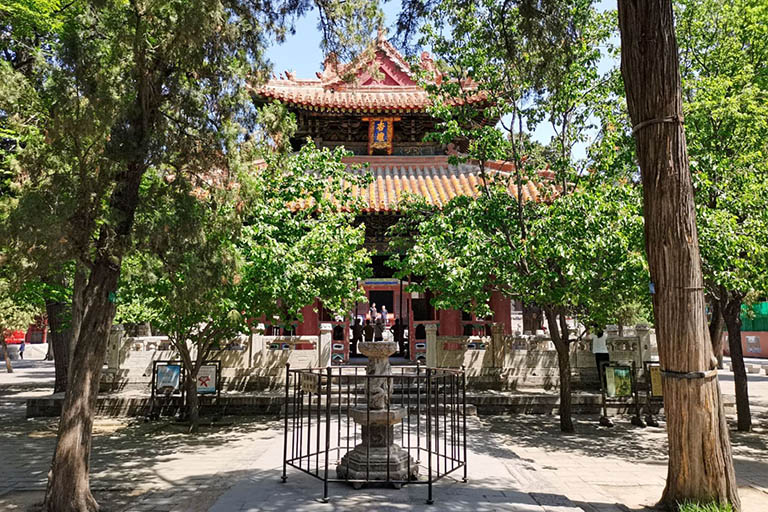 Xintan Pavilion 杏坛
Xintan Pavilion 杏坛
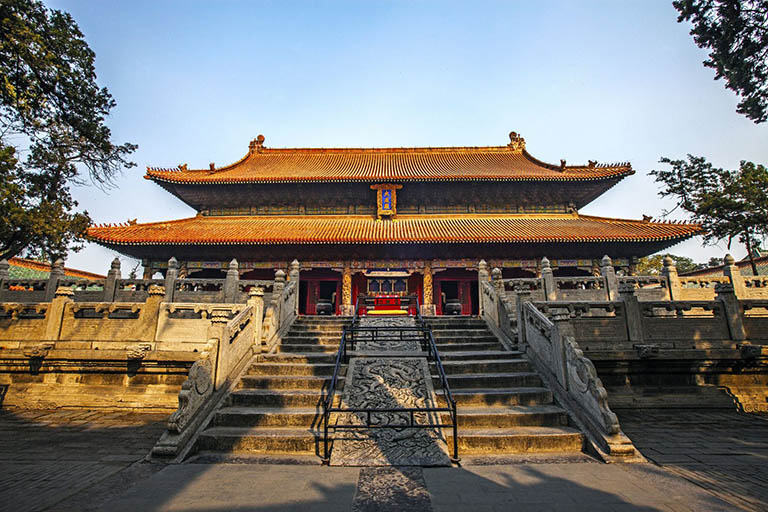 Dacheng Hall 大成殿
Dacheng Hall 大成殿
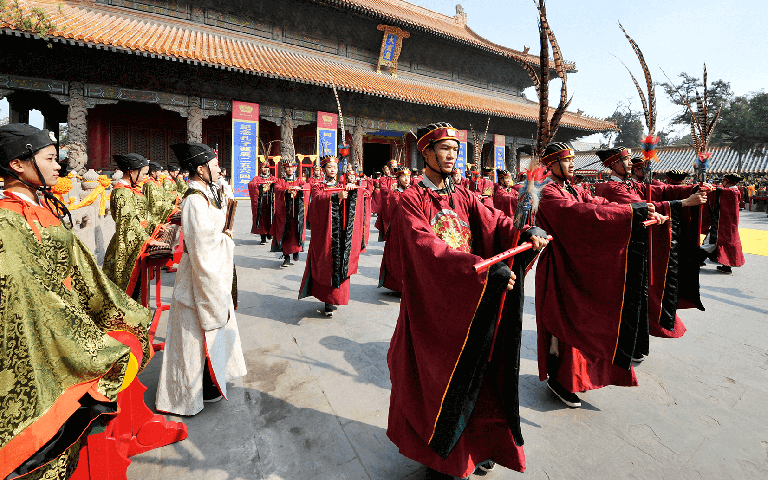 Opening Ceremony of Confucius Cultural Festival
Opening Ceremony of Confucius Cultural Festival
Kong Family Mansion 孔府
•
•
Located in the east of Confucius Temple, the Kong Family Mansion (Chinese: 孔府; pinyin: Kǒng fǔ), also known as Yansheng mansion, was the historical residence of the direct descendants of Confucius in the City of Qufu.
The Kong family was in charge of conducting religious ceremonies on occasions such as plantings, harvests, honoring the dead, and birthdays. Today, the mansion is a museum and part of the UNESCO World Heritage Site "Temple and Cemetery of Confucius and the Kong Family Mansion in Qufu".
The extant structures mainly date from the Ming and Qing dynasties, including total of 463 halls, rooms, pavilions, and porches, with nine courtyards. It is a typical Chinese aristocratic family compound. It is the residence of Confucius' lineage for a long time. It is also a typical building of the combination of official office and inner house in Chinese feudal society. After the death of Confucius, the descendants lived beside the temple for generations, guarding the temple and taking care of the remains of Confucius. By the end of the Northern Song Dynasty, the houses of the descendants of Confucius had expanded to dozens of houses. Until the Jin Dynasty, the descendants of Confucius had been in the East of the temple. With the promotion of the official position of Confucius, the buildings of Confucius government expanded continuously and reached the present scale in Song, Ming, and Qing Dynasties. At present, the Confucius Mansion covers an area of about 7.4 hectares.
There is a front hall, middle house, and back garden. The front hall is the government office, which is divided into the hall, the second Hall, and the third hall. It is the place where the descendant of Confucius, Yan Shenggong deals with official business. In the front hall, there are six offices, serving the Confucius temple and the government.
The middle house, namely the inner house and the back garden, are the places where Yan Shenggong and his family members live. These houses are for the master, his wife, young masters, and young ladies. The daily necessities are displayed, such as old mahogany furniture and a new style sofa.
The backyard garden is also known as Tieshan garden. The park has a rockery, fish pond, flower dock, bamboo forest, and various bonsai. At present, there are many precious cultural relics preserved in the Confucius Mansion, such as bronze wares of Shang and Zhou dynasties, clothes of yuan and Ming Dynasties, ancient calligraphy and painting, bamboo carving and jade carving, porcelain enamel, and other art treasures. Besides, there are a large number of documents since the Ming and Qing Dynasties. The whole Confucius Mansion, Kong Family Mansion is like a museum with numerous treasures.
Top Recommended Qufu Tours:
✔ 6 Days Best of Shandong Tour (Jinan/Moun Tai/Qufu/Qingdao)
✔ 6 Days Classic Beijing & Shandong Tour (Beijing/Qufu/Mount Tai)
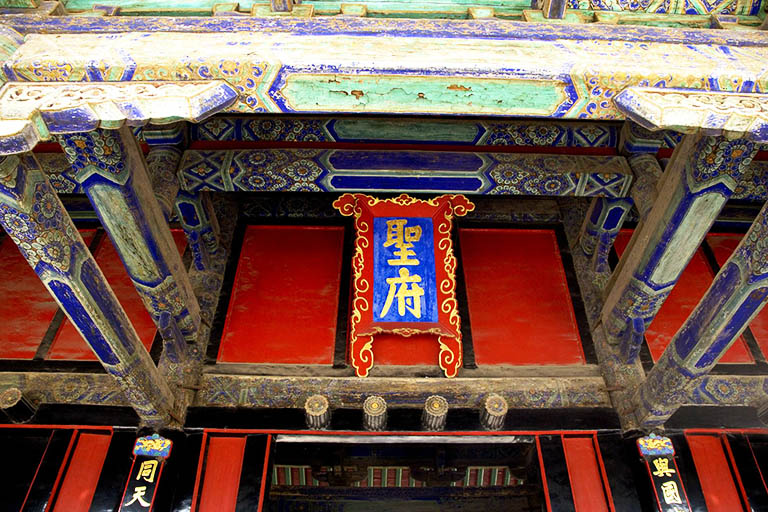 Gate of Kong Family Mansion
Gate of Kong Family Mansion
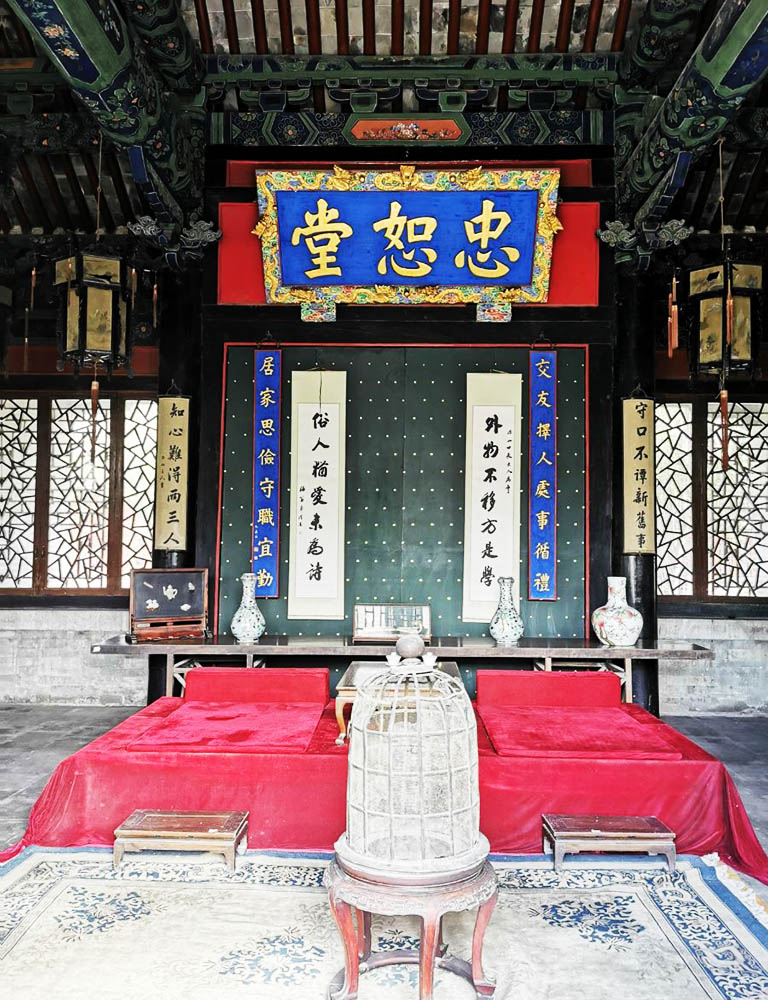 Shuzhong Hall of Kong Family Mansion
Shuzhong Hall of Kong Family Mansion
Confucius Cemetery 孔林
•
•
About 1km north of Qufu City, the Cemetery of Confucius (Chinese: 孔林; pinyin: Kǒng lín) is a cemetery of the Kong clan (the descendants of Confucius) in Qufu in Shandong province. Since 1994, the Cemetery of Confucius has been part of the UNESCO World Heritage Site "Temple and Cemetery of Confucius and the Kong Family Mansion in Qufu".
Confucius himself and some of his disciples are buried there, as well as many thousands of his descendants. Here, the tombs of more than 100,000 descendants of Confucius, who have been buried there over a period of about 2,000 years, can be found. The oldest graves date back to the Zhou Dynasty, the most recent of which belong to descendants in the 76th and 78th generation.
It is the largest, longest-lasting, and best-preserved clan tomb group and artificial garden in China with 7000 meters cemetery wall, and it is also the largest clan cemetery with the longest time span in the world. Over 1000 green cypresses and pine trees lining up on both sides of the road, many of them were planted in the Song and Yuan Dynasties, which gives the cemetery a forest-like appearance. A road runs from the north gate of Qufu to the exterior gate of the cemetery in a straight line. Along this road lies the Yan Temple, dedicated to Confucius' favorite student.
At the end of the forest is the wooden archway of "Zhishenglin - Holy Forest,至圣林 in Chinese", which is the gate of Konglin, Confucius Cemetery. From here to the north is Erlin gate, a castle-like building, also known as "Guanlou 观楼". Not far from Guanlou is the Xiangdian hall, which is the place where the incense altar is placed when offering sacrifices to Confucius. Behind the hall, the great tombstone of Confucius is placed there, which were engraved with "Dacheng Zhisheng Wenxuan Lord's Tomb 大成至圣文宣王墓". In the East is the tomb of Kong Li, his son; before that, it is the tomb of Kong Ji (Zisi), his grandson. The gigantic cemetery took hundreds of years to build.
The construction work of the cemetery started from the Song Dynasty and began on the wall and gate in 1331. It has undergone 13 renovations and extensions. Eventually, by the late 18th century, the perimeter wall reached a length of 7.5 kilometers (4.7 mi), enclosing an area of 3.6 square kilometers (1.4 sq mi).
Top Recommended Confucius Temple Tours:
✔ 6 Days Best of Shandong Tour (Jinan/Moun Tai/Qufu/Qingdao)
✔ 6 Days Classic Beijing & Shandong Tour (Beijing/Qufu/Mount Tai)
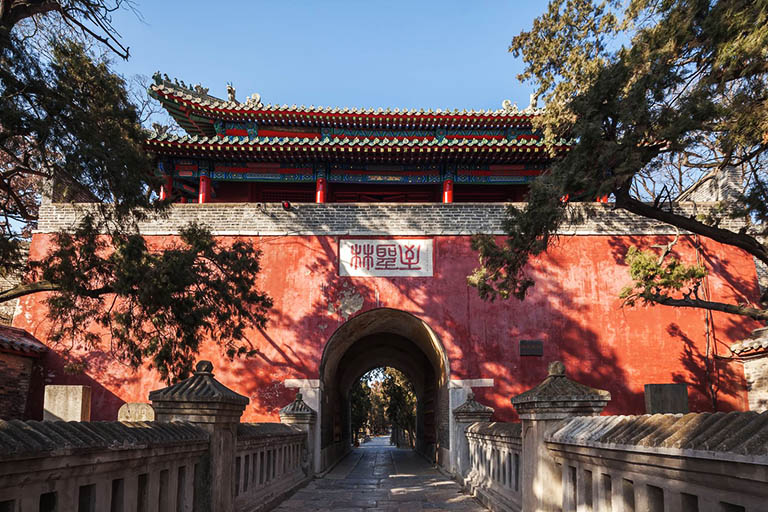 Zhishenglin Archway of Confucius Cemetery
Zhishenglin Archway of Confucius Cemetery
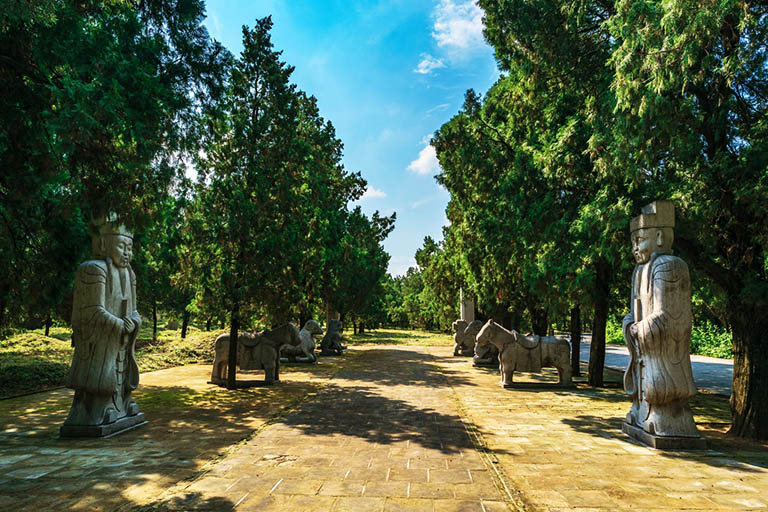 Forested Road to the Cemetery
Forested Road to the Cemetery
 Tombstone of Confucius
Tombstone of Confucius
How to Get to Confucius Temple in Qufu
Located in Qufu city center, Confucius Temple is easy to reach by bus and taxi. It is only about 5km from Qufu Railway Station (about 15min by car) and 13km from the high-speed train station - Qufu East Railway Station (about 30min by car). For the short distance among the site of “San Kong”, Confucius Temple is usually visited with Kong Family Mansion and Confucius Cemetery.
Confucius Temple Location: Near No. 17, Nanma Road West Street, Qufu City, Shandong Province山东省曲阜市南马道西街17号附近
● Get to Confucius Temple By Bus:Bus No. 2, 3, 5
● Qufu Railway Station to Confucius Temple: about 5 km, 15 minutes by taxi
● Qufu East Railway Station to Confucius Temple: about 13 km, 30min by taxi
Best time to visit Confucius Temple, Qufu
The average annual temperature in Qufu is 13.6 °C (56.5 °F). Generally speaking, visiting the Confucius Temple in Qufu is suitable for all seasons. The best season to visit Qufu is from spring to autumn, namely March to early November. In summer, it is the golden season for tourists to pass through lush trees and blooming flowers. Every autumn, Qufu will hold a large-scale international Confucius Culture Festival. During the festival, a grand opening ceremony will be held.
Nearby Attractions to Travel with Confucius Temple in Qufu
Temple of Yan Hui
Location: No.4 Gulou North Street, Qufu City, Jining City, Shandong Province 山东省济宁市曲阜市鼓楼北街4号
Ticket: CNY 50
Yan Hui is the favorite disciple of Confucius. Yan Hui is also famous for his virtue among the disciples of Confucius. Yan temple, also known as Fusheng temple, is located in the north gate of Qufu City, Shandong Province, opposite the back garden of Kong Family Mansion. It is a temple for worshiping Yan Hui.
Temple of Duke Zhou
Location: No.4, Gulou North Street, Qufu City, Jining City, Shandong Province 山东省济宁市曲阜市鼓楼北街4号
Ticket: CNY 50
Temple of Duke Zhou or Zhougong temple is a temple for worshiping Duke Zhou. Duke of Zhou, surnamed Ji and Dan, is the fourth son of King Wen of the Zhou Dynasty. Because his manor was in Zhou, he was called Duke of Zhou. Zhougong temple was built many times through the Song, Yuan, Ming, and Qing Dynasties. Zhougong temple is close to Confucius Temple and Yan temple, covering an area of 31310 square meters.
Wumaci Night Market
Location: No.4, Gulou North Street, Qufu City, Jining, Shandong Province 山东省济宁市曲阜市鼓楼北街4号
Ticket: Free Admission
Wumaci street is the largest commercial street in Qufu City. There was a Confucius ancestral hall built in the late Ming Dynasty, which was named "Wuma ancestral temple". There are four stories of GuiDe Pavilion(归德阁) in the middle of the street where you can see the beautiful scenery of Qufu city. The night market on the street is very famous in the local area, all kinds of local dishes and snacks can be found there.
Mount Ni
Location:Huangtu Village, Nishan Town, Qufu City, Jining City, Shandong Province 山东省济宁市曲阜市尼山镇黄土村
Ticket: CNY 120
340 meters above sea level, Mount Ni, located 30 kilometers southeast of Qufu City, is the birthplace of Confucius according to historical records. Besides beautiful natural scenery, there is a Confucius Temple and Nishan Academy on the east foot built in the Northern Zhou Dynasty with ancient tablets in the Yuan, Ming, and Qing Dynasties inside and outside the temple.
Popular Qufu Tours:
✔ 2 Days Mount Tai & Qufu Tour from Beijing by Bullet Train
✔ 3 Days Confucius Culture Exploration with Sidetrip to Mount Tai
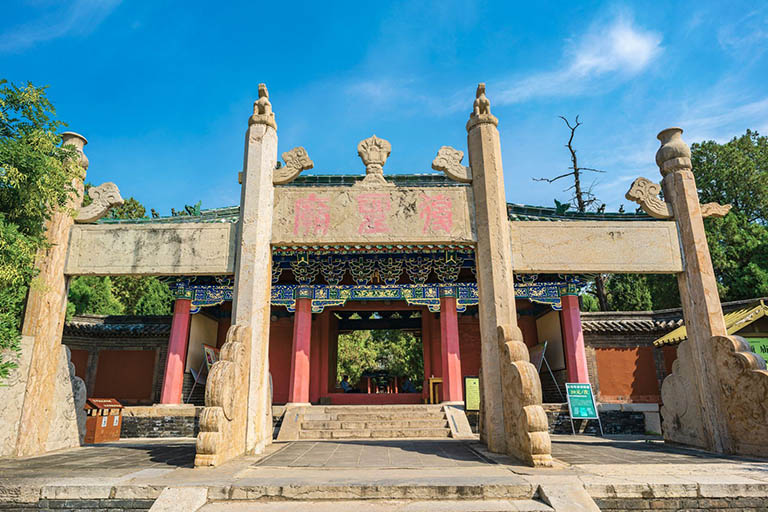 Temple of Yan Hui
Temple of Yan Hui
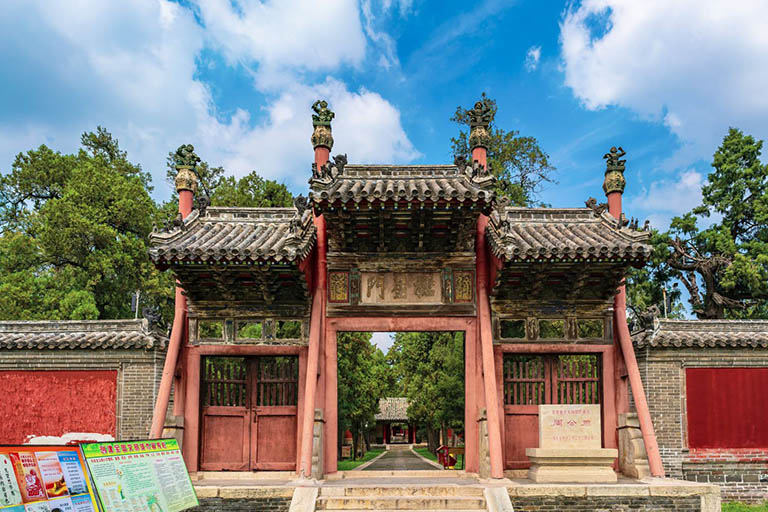 Temple of Duke Zhou
Temple of Duke Zhou
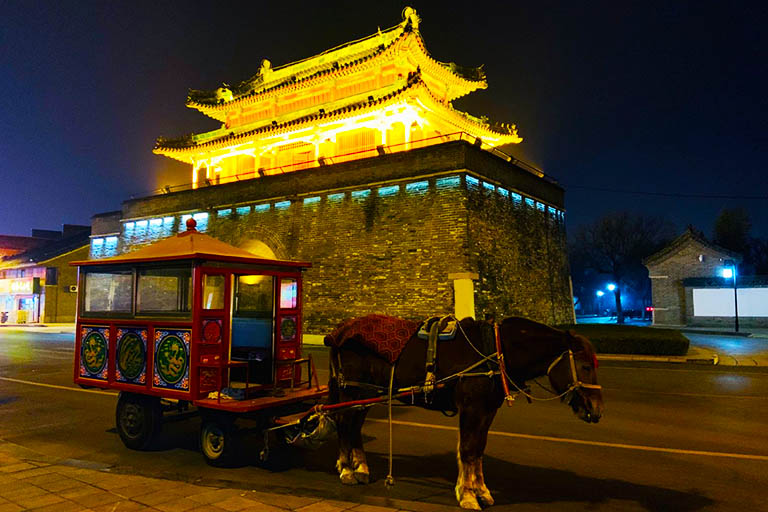 Wumaci Night Market
Wumaci Night Market
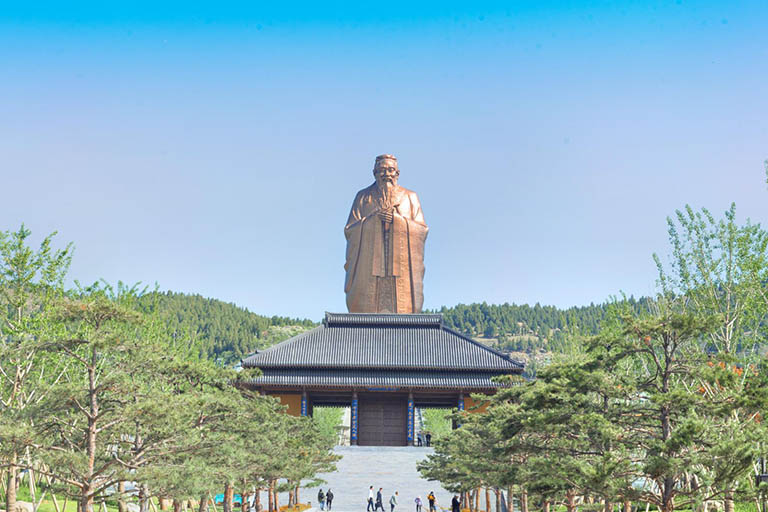 Mount Ni
Mount Ni
How to Plan Your Qufu Tour
How to Get to Qufu: The best way is taking high speed trains to Qufu from Beijing (about 2.5 hrs), Jinan (about 30~40 mins), Tai’an (about 20 mins), Qingdao (about 2.5~3.5 hrs)…
Best Time to Visit Qufu: March to November when the temperature is pleasant, natural scenery is beautiful and International Confucius Cultural Festival is usually held in autumn.
Top Attractions to Visit in Qufu: Temple of Confucius, Kong Family Mansion, Cemetery of Confucius…
Qufu, the “Hometown of Confucius”, is a holy cultural destination in the southwest of Shandong. The most popular and recommended tour itinerary of Qufu is making a day-trip to discover the three famous UNESCO World Cultural Heritage sites - Temple & Cemetery of Confucius and Kong Family Mansion together. Within short distance and convenient transportation, tourists usually visit Qufu with the sacred Mount Tai, a World Cultural & Natural Heritage site in Tai’an to witness impressive natural landscape and imperial traces.
✔ 2 Days Mount Tai Qufu Tour from Beijing by Bullet Train
✔ 3 Days Confucius Cultural Exploration with Sidetrip to Mount Tai
As a coastal province with long history, Shandong owns many more wonderful destinations worth your exploration. After your Qufu & Mount Tai hiking trip, you can further tour scenic Jinan with 1 day; travel to Qingdao, spend 2 days experiencing energetic beer culture and brisk seaside scenery, get to Weifang, Yantai, Weihai and more lovely cities. A highlight tour of Shandong with Qufu takes 4 to 6 days, covering major destinations and tourist essences.
✔ 4 Days Jinan Mount Tai Qufu Cultural Tour
✔ 4 Days Qingdao Qufu Mount Tai Essence Tour
✔ 6 Days Best of Shandong Tour (Jinan/Mount Tai/Qufu/Qingdao)
Based on your holiday time and individual interests, you may continue your China tour to Beijing and nearby regions of Shandong, or travel to Shanghai, Xian, Chengdu, Guilin and other top famous destinations to view different fascinating nature and culture of China.
✔ 6 Days Classic Beijing & Shandong Tour (Beijing/Qufu/Mount Tai)
✔ 8 Days Beijing Shanghai Tour with Confucianism Exploration & Mount Tai Hiking
✔ 10 Days China World Heritage Tour in Northern China (Beijing/Mount Tai/Qufu/Shaolin Temple/Luoyang/Xian)
Travel with China Discovery
China Discovery is an experienced, professional and reliable travel companion devoted to offering high-quality and the best tour services for all travelers to China. In order to have a hassle-free travel and focus on the trip itself, it’s highly recommended travelling with China Discovery. So, you can enjoy convenient airport pick-up and drop-off service and transportation to all scenic spots in a safe, clean, comfortable, air-conditioned and non-smoking vehicle. Also, we will arrange knowledgeable local tour guide, excellent accommodation and dining arrangements to ensure you rest well and get better understanding of Confucian culture in Qufu, spring culture in Jinan and Mount Tai culture in Shandong. You may select a favorite from our most popular Qufu tours or contact us to design a unique itinerary according to your personal time and preference.
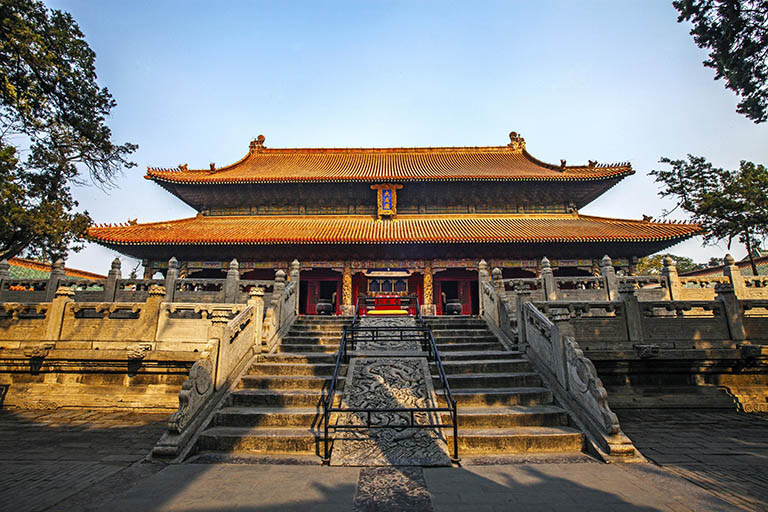 Temple of Confucius in Qufu
Temple of Confucius in Qufu
 Sacred Mount Tai in Tai'an
Sacred Mount Tai in Tai'an
 Our American Group Tourists Visited Mutianyu Great Wall in Beijing
Our American Group Tourists Visited Mutianyu Great Wall in Beijing
Qufu Travel Guide
- Popular Qufu Tours
- Qufu Travel Guide
- Top Things to Do
- Get to & around Qufu
- Get from Jinan to Qufu
- Qufu Train Stations
- Where to Stay in Qufu
- Qufu Weather & Seasons
- Useful Qufu Maps
Shandong Travel Guide
- Popular Shandong Tours
- Shandong Travel Guide
- Shandong Trip Planner
- Top Shandong Destinations
- Top Things to Do
- Get to & Around
- Best Shandong Hotels
- Shandong Weather & Seasons
- Shandong Maps
- Qingdao Travel Guide
- Mount Tai Travel Guide
- Qufu Travel Guide
- Yantai Travel Guide
- Weifang Travel Guide
- Weihai Travel Guide
- Penglai Travel Guide
- Zibo Travel Guide
- Linyi Travel Guide
Recommended Qufu Tours
Top 3 Qufu tours chosen by most customers to explore Qufu in the best way. Check the detailed itinerary, or tailor your own trip now with us.

3 Days Confucius Culture Exploration with Sidetrip to Mount Tai
Qufu / Mount Tai

2 Days Mount Tai Qufu Tour from Beijing by Bullet Train
Beijing / Mount Tai / Qufu

8 Days Beijing Shanghai Tour with Confucianism Exploration & Mount Tai Hiking
Beijing / Mount Tai / Qufu / Shanghai
Start planning your tailor-made holiday to China by contacting one of our specialists. Once inquired, you’ll get a response within 0.5~23.5 hours.
Customize a TripHave a question? Get answers from our travel experts or guests
- Your Question:
- Your Name:
- Your Email:
- Submit

























